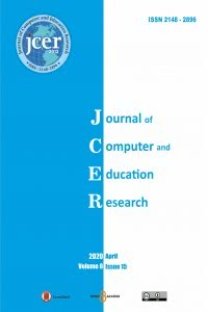İlkokul 3. Sınıf Fen Bilimleri Ders Kitabında: Dilbilgisel Eğretileme Olarak Adlaştırma
İlkokul 3. sınıf fen bilimleri ders kitabı, dilbilgisel eğretileme, adlaştırma
In Primary School 3th Grade Science Textbook: Nominalization as Grammatical Metaphor
___
- Banks, D. (2008). The development of scientific writing: Linguistic features and historical context. London: Equinox. Baratta, M. A. (2010). Nominalization development across an undergraduate academic degree program. Journal of Pragmatics, 42(4), 1017–1036.
- Cengiz, Ö., & Çakır, H. (2012). Okul öncesi çocukların dilbilgisel eğretileme kullanımının ortaya çıkış sürecinde annelerin etkisi. Dilbilim Araştırmaları Dergisi, 2, 21-36.
- Çakır, H. (2011). Türkçe ve İngilizce bilimsel makale özetlerinde bilgiyi kurgulama ve yazar kimliğini kodlama biçimleri. (Yayımlanmamış doktora tezi). Dokuz Eylül Üniversitesi, İzmir.
- Çakır, H., & Cengiz, Ö. (2017). Dilbilim çeviribilim yazıları, Kansu-Yetiner, N., & Şahin, M. (Ed). Anneler ve çocuklarının adlaştırma kullanımı (ss. 55-66). Ankara: Anı Yayıncılık
- Derewianka, B. (2003). Grammatical metaphor: Views from systemic-functional linguistics, Simon-Vandenbergen, A.M., Taverniers, M. & Ravelli, L. (Ed.). Grammatical metaphor in the transition to adelescence (pp. 185-219). Amsterdam: John Benjamins.
- Göksel, A., & Kerslake, C. (2005). Turkish: a comprehensive grammar. London ve New York: Routledge.
- Halliday, M. A. K. (1985). An introduction to functional grammar (1st ed.). London: Edward Arnold.
- Halliday, M. A. K. (1994). An introduction to functional grammar (2nd ed.). London: Edward Arnold.
- Halliday, M. A. K. (2003). The language of early childhood. London: Continuum.
- Halliday, M. A. K., & Matthiessen, C. M. I. M. (2004). An introduction to functional grammar (3rd ed.). London: Edward Arnold.
- Jalilifar, A., Alipour, M. & Parsa, S. (2014). A comparative study of nominalization in applied linguistics and biology books. Journal of Research in Applied Linguistics, 5(1), 24-43.
- Jalilifar, A., Memari, M. (2017). Exploring Nominalization in Physics and Applied Linguistics Textbooks with Different Levels of Difficulty: Implications for English for Specific Purposes. Teaching English Language, 11(2), 131-159.
- Jalilifar, A., White, P., & Malekizadeh, N. (2017). Exploring nominalization in scientific textbooks: A cross-disciplinary study of hard and soft sciences, International Journal of English Studies, 17(2), 1-20.
- Karasar, N. (2009). Bilimsel araştırma yöntemi. (20. Baskı). Ankara: Nobel Yayın Dağıtım
- Kazemian, B., Behnam, B., & Ghafoori, N. (2013). Ideational grammatical metaphor in scientific texts: A Hallidayan perspective. International Journal of Linguistics, 5(4), 146-168.
- Mahbudi, A., Mahbudi, L., & Amalsaleh, E. (2014). A comparison between the use of nominalization in medical papers by English and Iranian writers. International Journal of Applied Linguistics and English Literature, 3(6), 1-6.
- Mẫu, V. T. (2012). Grammatical metaphor in English pharmaceutical discourse. (Unpublished MA thesis). University of Languages and International Studies, Vietnam.
- MEB (2017a). Fen bilimleri dersi öğretim programı (İlkokul ve Ortaokul 3, 4, 5, 6, 7 ve 8. Sınıflar). Ankara: Milli Eğitim Bakanlığı Talim Terbiye Kurulu Başkanlığı.
- MEB (2017b). İlkokul fen bilimleri 3.sınıf ders kitabı. Ankara: Milli Eğitim Bakanlığı Yayınları
- Mueller, B. M. (2015). Analysis of nominalization in elementary and middle school science textbooks. ( Unpublished MA thesis). Hamline University, Minnesota, America.
- Schleppegrell, M. J. (2004). The language of schooling: A functional linguistics approach, Mahwah, NJ: Lawrence Erlbaum Associates
- Sušinskienė, S. (2009). Textual functions of nominalizations in English scientific discourse. Žmogus ir žodis, 11(3), 58–64.
- Painter, C. (2003). Views from systemic-functional linguistics, Simon-Vandenbergen, A.M., Taverniers, M., & Ravelli, L. (Ed.). Grammatical metaphor: The use of metaphorical mode of meaning in early language development (pp. 151-167). Amsterdam: John Benjamins.
- Tabrizi, F.,& Nabifar, N. (2013). A comparative study of ideational grammatical metaphor in health and political texts of English newspaper. Journal of Academic and Applied Studies, 3(1), 32-51.
- Taverniers, M. (2004). Grammatical metaphors in English. Moderna Sprak, 98 (1), 17–26.
- Torr, J., & Simpson , A. (2003). Grammatical metaphor: Views from systemic-functional linguistics, Simon-Vandenbergen, A.M., Taverniers, M., & Ravelli, L (Ed.). The emergence of grammatical metaphor: Literacy oriented expressions in the everyday speech of young children (pp. 169-183). Amsterdam: John Benjamins.
- TDK (2018). Eğretileme. http://www.tdk.gov.tr/index.php?option=com_bts&view=bts&kategori1=veritbn&kelimesec=107736 adresinden 1Ekim 2018 tarihinde alınmıştır.
- Türkkan, B. (2008). Türkçe tarih söyleminde adlaştırmanın işlevleri. (Yayımlanmamış doktora tezi). Dokuz Eylül Üniversitesi, İzmir.
- Wenyan, G. (2012). Nominalization in medical papers: A comparative study. Studies in Literature and Language, 4(1), 86-93.
- Yıldırım, A. & Simsek, H. (2016). Sosyal bilimlerde nitel araştırma yöntemleri. ( Genişletilmiş 10. Baskı). Ankara: Seçkin Yayıncılık.
- Yongjie, C. (2007). A contrastive study of English nominalization in abstracts of science and technology research papers. (Unpublished MA thesis). Shangai Jiao Tong University, China.
- Yayın Aralığı: Yılda 2 Sayı
- Başlangıç: 2013
- Yayıncı: Tamer KUTLUCA
A Case Study on Students’ Identity Perceptions Using Literary Sources in Reading Courses
Yıldırım ÖZSEVGEÇ, Volkan MUTLU
Matematik Öğretmen Adaylarının, Matematik Etkinliklerindeki Sanata Yönelik Metaforik Algıları
Ebru KÜKEY, Hilal KÜKEY, Tayfun TUTAK
Ebru KÜKEY, Recep ASLANER, Tayfun TUTAK
Ortaya Çıkan Modelleme Yaklaşımıyla Kavramlaştırma Süreci: Sembolleştirme Örneği
The Scale of Happiness Strategies for Children’s used by Preschool Teachers
Özkan SAPSAĞLAM, Ali ERYILMAZ, Ayça Bahar BAKKALOĞLU
Mathematics Teachers’ Views on Mathematical Thinking
Emine Nur ÜNVEREN BİLGİÇ, Ayşe Zeynep AZAK
Teknoloji Destekli Probleme Dayalı Öğretim Uygulamalarının Matematik Başarısına Etkisi
Yücel ÇETİN, Şeref MİRASYEDİOĞLU
An Examination of Middle School 7th Grade Students’ Mathematical Abstraction Processes
